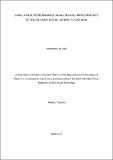| dc.description.abstract | With the environmental advantages of solar energy, the use of solar photovoltaic (PV) in electricity generation is encouraged by Tanzanian governments, however, the number of institutions that are benefiting from installing grid-connected PV system and the electricity being generated are not clearly documented. Thus, in this study simulation, performance analysis and improvements of grid connected and standby PV system at Karume Institute of Science and Technology (KIST, Zanzibar) as well as Nelson Mandela African Institution of Science and Technology NM-AIST, Arusha) have been carried out. The analysis utilizes the power load data from the two different locations in Tanzania. The data (current and voltages) were obtained using the data loggers and the outputs such as power and energy were calculated. In addition, HOMER (Hybrid Optimization Model for Electric Renewables) software developed by the National Renewable Energy Laboratory (NREL), Department of Energy, United States of America was used to design and evaluate technical-performance and financial- options for off-grid and on-grid power systems for remote, stand-alone and distributed generation applications.
Therefore, in this study, the distance from the roof to the panel, reflection and inclination angles were observed to have significant impact on the performance of PV panels. High performance was recorded when the distance from the roof to the panel was 20 cm and the reflection and inclination angles were
45° and 20° respectively at KIST. The spacing provided good natural cooling of the panel while at the optimal reflection and inclination angles the solar intensity was improved due to the decreased angle of incidence. Additionally, the HOMER simulated results indicated that PV and grid combination at KIST exhibited the saving of 39.8% of the total energy consumption per day as compared to when only grid power is used, the cost of energy was reduced from $0.1877 to $0.113. In the other hand, the combination of grid, battery and PV systems at NM-AIST recorded the saving of 50.5% of energy usage per day, the cost of energy was reduced from $0.22 849 to $0.113. | en_US |

